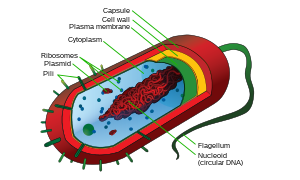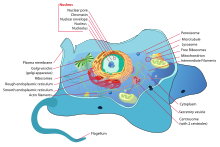The cell (from Latin cella, meaning "small room") is the basic structural, functional, and biological unit of all known living organisms A cell is the smallest unit of life. Cells are often called the "building blocks of life". The study of cells is called
Cells consist of cytoplasm enclosed within a membrane, which contains many biomolecules such as proteins and nucleic acids Organisms can be classified as unicellular (consisting of a single cell; including bacteria) or multicellular (including plants and animals).[ While the number of cells in plants and animals varies from species to species, humans contain more than 10 trillion (1013) cells. Most plant and animal cells are visible only under a microscope, with dimensions between 1 and 100 micrometres.
Cells were discovered by Robert Hooke in 1665, who named them for their resemblance to cells inhabited by Christian monks in a monastery. Cell theory , first developed in 1839 by Matthias Jakob Schleiden and Theodor Schwann states that all organisms are composed of one or more cells, that cells are the fundamental unit of structure and function in all living organisms, and that all cells come from pre-existing cells. Cells emerged on Earth at least 3.5 billion years ago.
Overview
Cells are of two types: eukaryotic , which contain a nucleus, and prokaryotic, which do not. Prokaryotes are single-celled organisms , while eukaryotes can be either single-celled or multicellular.
Prokaryotic cells

Structure of a typical prokaryotic cell
Prokaryotes include bacteria and archaea, two of the three domains of life . Prokaryotic cells were the first form of life on Earth, characterised by having vital biological processes including cell signaling . They are simpler and smaller than eukaryotic cells, and lack membrane-bound organelles such as a nucleus. The DNA of a prokaryotic cell consists of a single chromosome that is in direct contact with the cytoplasm. The nuclear region in the cytoplasm is called the nucleoid. Most prokaryotes are the smallest of all organisms ranging from 0.5 to 2.0 µm in diameter.
A prokaryotic cell has three architectural regions:
- Enclosing the cell is the cell envelope – generally consisting of a plasma membranecovered by a cell wall which, for some bacteria, may be further covered by a third layer called a capsule. Though most prokaryotes have both a cell membrane and a cell wall, there are exceptions such as Mycoplasma (bacteria) and Thermoplasma(archaea) which only possess the cell membrane layer. The envelope gives rigidity to the cell and separates the interior of the cell from its environment, serving as a protective filter. The cell wall consists of peptidoglycan in bacteria, and acts as an additional barrier against exterior forces. It also prevents the cell from expanding and bursting (cytolysis) from osmotic pressuredue to a hypotonic environment. Some eukaryotic cells (plant cells and fungalcells) also have a cell wall.
- Inside the cell is the cytoplasmic region that contains the genome (DNA), ribosomes and various sorts of inclusions.The genetic material is freely found in the cytoplasm. Prokaryotes can carry extrachromosomal DNA elements called plasmids , which are usually circular. Linear bacterial plasmids have been identified in several species of spirochete bacteria, including members of the genus Borrelia notably Borrelia burgdorferi which causes Lyme disease.Though not forming a nucleus, the DNA is condensed in a nucleoid. Plasmids encode additional genes, such as antibiotic resistance genes.
- On the outside, flagella and pili project from the cell's surface. These are structures (not present in all prokaryotes) made of proteins that facilitate movement and communication between cells.

Structure of a typical plant cell
Eukaryotic cells
Plants, animals, fungi, slime moulds, protozoa, and algae are all eukaryotic . these cells are about fifteen times wider than a typical prokaryote and can be as much as a thousand times greater in volume. the main distinguishing feature of eukaryotes as compared to prokaryotes
prokaryot is compartmentalization: the presence of membrane-bound organelles (compartments) in which specific activities take place. Most important among these is a cell nucleus an organelle that houses the cell's DNA. This nucleus gives the eukaryote its name, which means "true kernel (nucleus)". Other differences include:
- The plasma membrane resembles that of prokaryotes in function, with minor differences in the setup. Cell walls may or may not be present.
- The eukaryotic DNA is organized in one or more linear molecules, called chromosomes , which are associated with histone proteins. All chromosomal DNA is stored in the cell nucleus , separated from the cytoplasm by a membrane. Some eukaryotic organelles such as mitochondriaalso contain some DNA.
- Many eukaryotic cells are ciliated with primary cilia. Primary cilia play important roles in chemosensation, mechanosensation, and thermosensation. Cilia may thus be "viewed as a sensory cellular antennae that coordinates a large number of cellular signaling pathways, sometimes coupling the signaling to ciliary motility or alternatively to cell division and differentiation."
- Motile eukaryotes can move using motile cilia or flagella. Motile cells are absent in conifers and flowering plants Eukaryotic flagella are less complex than those of prokaryotes.





Comments
Post a Comment